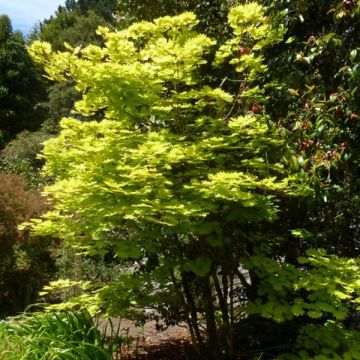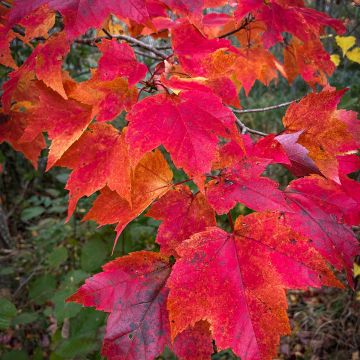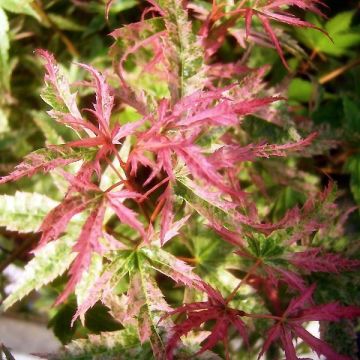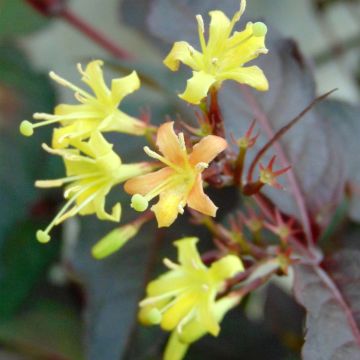

Acer pentaphyllum - Chinese maple
Acer pentaphyllum - Chinese maple
Acer pentaphyllum
Chinese maple, five-lobe maple
Why not try an alternative variety in stock?
View all →This plant carries a 24 months recovery warranty
More information
We guarantee the quality of our plants for a full growing cycle, and will replace at our expense any plant that fails to recover under normal climatic and planting conditions.
Oversize package: home delivery by special carrier from €6.90 per order..
Express home delivery from €8.90.
Delivery to Corse prohibited: UE law prohibits the import of this plant from mainland France to Corse as part of the fight against Xylella fastidiosa. Please accept our sincere apologies.
More information
Does this plant fit my garden?
Set up your Plantfit profile →
Description
Acer pentaphyllum, or five-leaved maple, is a Chinese tree, rare in cultivation and endangered in the wild. It has a beautiful upright, transparent, flexible habit, and is characterised by leaves composed of 5 slender leaflets. In autumn, its foliage turns fiery red before falling. It is not very hardy and will thrive in the understory, in the shade of larger trees, in a rich humus soil that remains moist but well-drained, and protected from cold winds.
The five-leaved maple belongs to the botanical family Sapindaceae (which has absorbed the former family of maples, Aceraceae). Originating from China, specifically from the provinces of Guizhou, Hubei, Shaanxi, and Sichuan, this species grows in mixed forests, valleys, and slopes, at altitudes ranging from 1000 to 2000 metres. It is a deciduous small tree that can reach between 3 and 5 metres in height in our climates, up to 10 metres in the wild. Its spread reaches 2.50 to 5 metres. It has a grey-brown bark, smooth when young, which becomes slightly fissured and scaly with age. Its branches are slender and greyish, slightly drooping, and its winter buds are reddish-brown. The leaves of Acer pentaphyllum are opposite on the branches and generally have five leaflets, hence its name. They are oval to elliptical, measuring between 8 and 15 cm in length, and have finely toothed edges. In spring, they emerge with a bronze tint, then become dark green and shiny in summer, before turning to magnificent autumn colours ranging from yellow to scarlet red. The flowers of this maple are yellow-green, arranged in drooping panicles, and appear in spring after the leaves. They are followed by winged fruits, which ripen in autumn. The samaras of Acer pentaphyllum are green when immature, then turn brown when mature. They measure about 2 to 3 cm in length and are arranged in hanging clusters. Birds and squirrels also appreciate the seeds as a source of food.
Reserve a special place for this collector's maple, in isolation, at the edge of an understory, where you will have the opportunity to admire it. However, Acer pentaphyllum can also be planted in different areas of the garden depending on the desired effect. It can be used as a specimen tree on a slightly shaded lawn to highlight its elegant silhouette and colourful foliage. It can also be planted in groups with Japanese maples and flowering dogwoods, to vary the texture and colour of the foliage. Shade-loving perennial plants and ferns can be used to cover the ground around this small tree and add diversity to the garden. Among the plants that can be associated with Acer pentaphyllum are fragrant hostas or astilbes for their light panicle flowers and dissected foliage.
Report an error about the product description
Plant habit
Flowering
Foliage
Botanical data
Acer
pentaphyllum
Sapindaceae
Chinese maple, five-lobe maple
China
Other Acer - Maple tree
Planting and care
Acer pentaphyllum should be planted in the spring or autumn in fertile, well-drained soil, preferably acidic to neutral (non-calcareous), deep and moist, rich in humus, in a partially shaded position. Avoid morning sun exposure that could destroy the buds in late winter frosts. It requires the soil to remain moist throughout the year, without being waterlogged. Beware of strong winds. Keep the soil moist during the first two summers after planting. Mulching can be beneficial to maintain good soil moisture.
Planting period
Intended location
Care
This item has not been reviewed yet - be the first to leave a review about it.
Shrubs for semi-shade
Haven't found what you were looking for?
Hardiness is the lowest winter temperature a plant can endure without suffering serious damage or even dying. However, hardiness is affected by location (a sheltered area, such as a patio), protection (winter cover) and soil type (hardiness is improved by well-drained soil).

Photo Sharing Terms & Conditions
In order to encourage gardeners to interact and share their experiences, Promesse de fleurs offers various media enabling content to be uploaded onto its Site - in particular via the ‘Photo sharing’ module.
The User agrees to refrain from:
- Posting any content that is illegal, prejudicial, insulting, racist, inciteful to hatred, revisionist, contrary to public decency, that infringes on privacy or on the privacy rights of third parties, in particular the publicity rights of persons and goods, intellectual property rights, or the right to privacy.
- Submitting content on behalf of a third party;
- Impersonate the identity of a third party and/or publish any personal information about a third party;
In general, the User undertakes to refrain from any unethical behaviour.
All Content (in particular text, comments, files, images, photos, videos, creative works, etc.), which may be subject to property or intellectual property rights, image or other private rights, shall remain the property of the User, subject to the limited rights granted by the terms of the licence granted by Promesse de fleurs as stated below. Users are at liberty to publish or not to publish such Content on the Site, notably via the ‘Photo Sharing’ facility, and accept that this Content shall be made public and freely accessible, notably on the Internet.
Users further acknowledge, undertake to have ,and guarantee that they hold all necessary rights and permissions to publish such material on the Site, in particular with regard to the legislation in force pertaining to any privacy, property, intellectual property, image, or contractual rights, or rights of any other nature. By publishing such Content on the Site, Users acknowledge accepting full liability as publishers of the Content within the meaning of the law, and grant Promesse de fleurs, free of charge, an inclusive, worldwide licence for the said Content for the entire duration of its publication, including all reproduction, representation, up/downloading, displaying, performing, transmission, and storage rights.
Users also grant permission for their name to be linked to the Content and accept that this link may not always be made available.
By engaging in posting material, Users consent to their Content becoming automatically accessible on the Internet, in particular on other sites and/or blogs and/or web pages of the Promesse de fleurs site, including in particular social pages and the Promesse de fleurs catalogue.
Users may secure the removal of entrusted content free of charge by issuing a simple request via our contact form.
The flowering period indicated on our website applies to countries and regions located in USDA zone 8 (France, the United Kingdom, Ireland, the Netherlands, etc.)
It will vary according to where you live:
- In zones 9 to 10 (Italy, Spain, Greece, etc.), flowering will occur about 2 to 4 weeks earlier.
- In zones 6 to 7 (Germany, Poland, Slovenia, and lower mountainous regions), flowering will be delayed by 2 to 3 weeks.
- In zone 5 (Central Europe, Scandinavia), blooming will be delayed by 3 to 5 weeks.
In temperate climates, pruning of spring-flowering shrubs (forsythia, spireas, etc.) should be done just after flowering.
Pruning of summer-flowering shrubs (Indian Lilac, Perovskia, etc.) can be done in winter or spring.
In cold regions as well as with frost-sensitive plants, avoid pruning too early when severe frosts may still occur.
The planting period indicated on our website applies to countries and regions located in USDA zone 8 (France, United Kingdom, Ireland, Netherlands).
It will vary according to where you live:
- In Mediterranean zones (Marseille, Madrid, Milan, etc.), autumn and winter are the best planting periods.
- In continental zones (Strasbourg, Munich, Vienna, etc.), delay planting by 2 to 3 weeks in spring and bring it forward by 2 to 4 weeks in autumn.
- In mountainous regions (the Alps, Pyrenees, Carpathians, etc.), it is best to plant in late spring (May-June) or late summer (August-September).
The harvesting period indicated on our website applies to countries and regions in USDA zone 8 (France, England, Ireland, the Netherlands).
In colder areas (Scandinavia, Poland, Austria...) fruit and vegetable harvests are likely to be delayed by 3-4 weeks.
In warmer areas (Italy, Spain, Greece, etc.), harvesting will probably take place earlier, depending on weather conditions.
The sowing periods indicated on our website apply to countries and regions within USDA Zone 8 (France, UK, Ireland, Netherlands).
In colder areas (Scandinavia, Poland, Austria...), delay any outdoor sowing by 3-4 weeks, or sow under glass.
In warmer climes (Italy, Spain, Greece, etc.), bring outdoor sowing forward by a few weeks.



































































